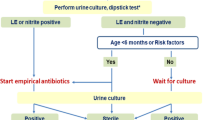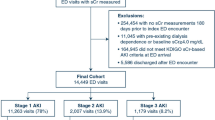Abstract
Purpose
To evaluate our clinical outcomes in managing acute kidney injury (AKI) resulting from ceftriaxone-induced urolithiasis with emergency treatment.
Methods
From July 2008 to July 2013, a series of 15 patients including 12 males and 3 females were admitted to our center. The mean age of them was (4.76 ± 3.74) years. A chief complaint of anuria was presented in 12 (80.0 %) patients for 13 h–4 days and that of oliguria in three (20.0 %) patients for 20 h–10 days. All of them were diagnosed of postrenal AKI resulting from ceftriaxone-induced urolithiasis and underwent emergency hospitalization.
Results
Double-J stenting with cystoscopy was successfully performed in nine patients (60.0 %), and ureteroscopy was applied in four patients (26.7 %). One patient (6.7 %) underwent unilateral double-J insertion combined with contralateral percutaneous nephrostomy, and one (6.7 %) underwent open surgery. Loose texture and sandlike stones, the main characteristics of these stones, made them excreted spontaneously after the initial treatment, whereas only one patient (6.7 %) underwent additional ureterolithotomy due to many residual calculi. Serum creatinine and blood urea nitrogen recovered to normal levels within 3 days. All specimens were collected and analyzed by infrared spectrum, with results demonstrating that the main composition was ceftriaxone calcique. All patients were followed up for 11 months–5 years (mean 33.80 ± 22.56 months). No one turned to irreversible renal failure.
Conclusions
Ceftriaxone could result in urolithiasis in children, which could also cause AKI. Appropriate and timely surgical management by conventional treatments will mostly lead to full recovery of renal functions.



Similar content being viewed by others
Abbreviations
- AKI:
-
Acute kidney injury
- URS:
-
Ureteroscopy
- PCN:
-
Percutaneous nephrostomy
- CT:
-
Computed tomography
- Cr:
-
Serum creatinine
- BUN:
-
Blood urea nitrogen
- CRRT:
-
Continuous renal replacement therapy
References
Sharon PA (2009) Acute kidney injury in children. Pediatr Nephrol 24:253–263
Vomiero G, Carpenter B, Robb I, Filer G (2002) Combination of ceftriaxone and acyclovir—an underestimated nephrotoxic potential? Pediatr Nephrol 17:633–637
Shokeir AA, Shoma AM, Abubieh EA, Nasser MA, Eassa W, EI-Asmy A (2002) Recoverability of renal function after relief of acute complete ureteral obstruction: clinical prospective study of the role of renal resistive index. Urology 59:506–510
Mehta RL, Kellum JA, Shal SV, Molitoris BA, Ronco C, Warnock DG, Levin A (2007) Acute kidney injury network: report of an initiative to improve outcomes in acute kidney injury. Crit Care 11:R31
Jia J, Shen X, Wang L, Zhang T, Xu M, Fang X, Xu G, Qian C, Wu Y, Geng H (2013) Extracorporeal shock wave lithotripsy is effective in treating single melamine induced urolithiasis in infants and young children. J Urol 189:1498–1502
Schaad UB, Wedgwood-Krucko J, Tschaeppeler H (1988) Reversible ceftriaxone-associated biliary pseudolithiasis in children. Lancet 2:1411–1413
Prince JS, Senac MO Jr (2003) Ceftriaxone-associated nephrolithiasis and biliary pseudolithiasis in a child. Pediatr Radiol 33:648–651
Akl KF, Masri AT, Hjazeen MM (2011) Acute urine retention induced by ceftriaxone. Saudi J Kidney Dis Transpl 22:1226–1228
Lu X, Wu R, Huang X, Zhang Y (2012) Noncontrast multidetector-row computed tomography scanning for detection of radiolucent calculi in acute renal insufficiency caused by bilateral ureteral obstruction of ceftriaxone crystals. J Xray Sci Technol 20:11–16
Boffa JJ, De Preneuf H, Bouadma L, Daudon M, Pallot JL (2000) Acute renal failure after amoxicillin crystallization. Presse Med 8:699–701
Kimata T, Kaneko K, Takahashi M, Hirabayashi M, Shimo T, Kino M (2012) Increased urinary calcium excretion caused by ceftriaxone: possible association with urolithiasis. Pediatr Nephrol 27:605–609
Kapur G, Valentini RP, Mattoo TK, Warrier I, Imam AA (2008) Ceftriaxone induced hemolysis complicated by acute renal failure. Pediatr Blood Cancer 50:139–142
Conflict of interest
None.
Author information
Authors and Affiliations
Corresponding author
Additional information
Xiaowei Shen and Wang Liu contributed equally to this work.
Rights and permissions
About this article
Cite this article
Shen, X., Liu, W., Fang, X. et al. Acute kidney injury caused by ceftriaxone-induced urolithiasis in children: a single-institutional experience in diagnosis, treatment and follow-up. Int Urol Nephrol 46, 1909–1914 (2014). https://doi.org/10.1007/s11255-014-0742-x
Received:
Accepted:
Published:
Issue Date:
DOI: https://doi.org/10.1007/s11255-014-0742-x




